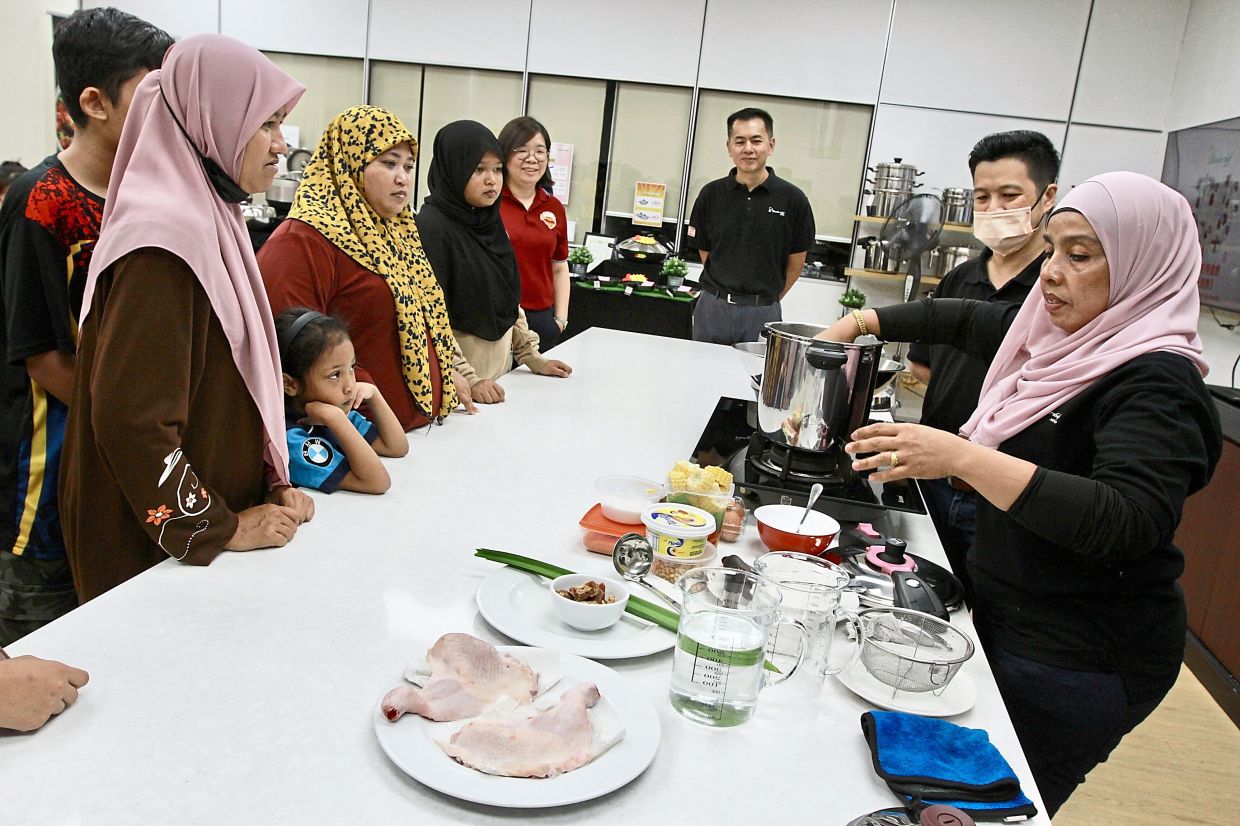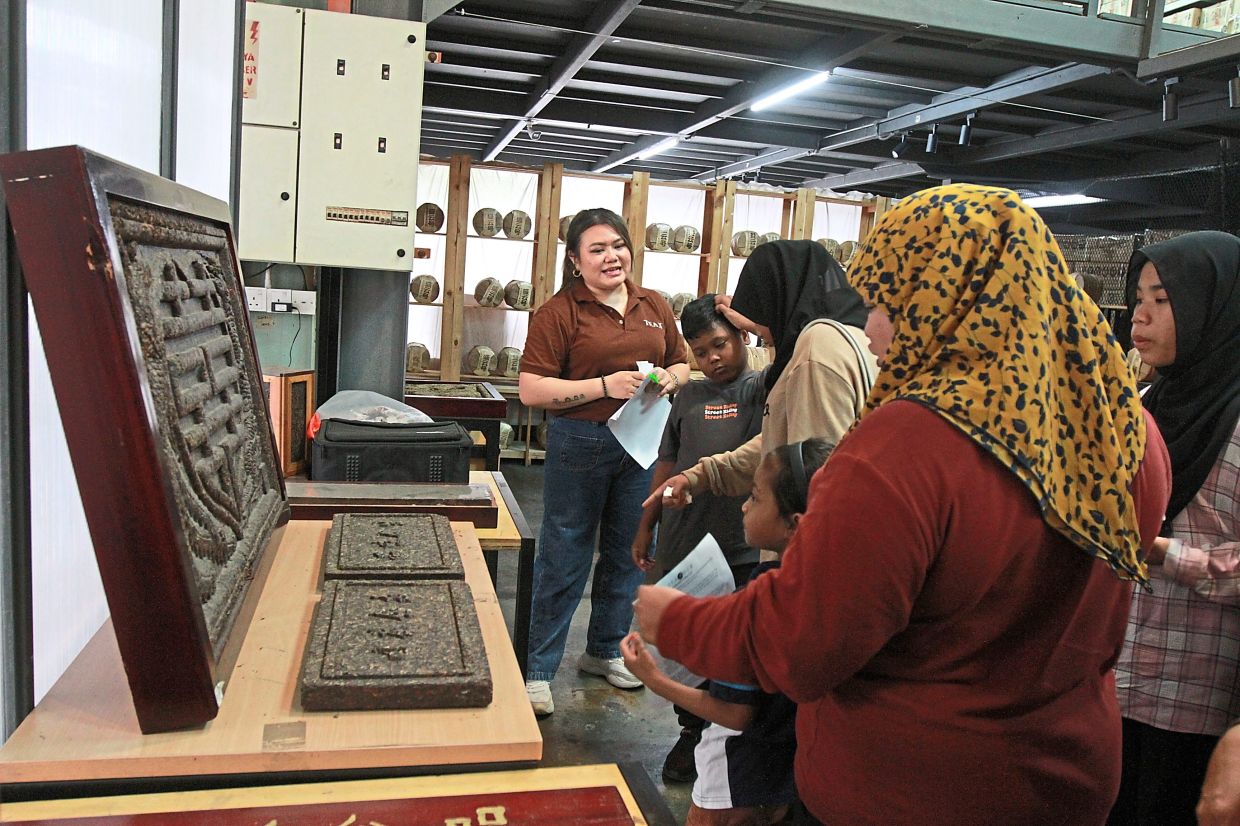Chia (left) showing tourists the soybean fermentation process at the soy sauce factory in Seri Kembangan. — Photos: LOW LAY PHON/The Star
Do you know that convex mirrors can be made of stainless steel instead of glass?
What about the fact that soy sauce gets its deep brown colour from its fermentation process?
These are just some of the interesting facts one will discover should they opt for a tour under the Balakong Industrial Tourism programme.
The programme expands on the concept of a factory tour, where visitors get to learn about a particular manufacturing process on site.
Balakong in Hulu Langat, Selangor, is ideal for this programme as it has some 3,000 factories spread across four industrial parks – Balakong Jaya, Selesa Jaya, Tanming Jaya and Kampung Baru Balakong.
According to state government data, Kampung Baru Balakong with 21.04ha is the largest of the four.
Balakong also has the largest number of small-to-medium enterprises (SMEs) in the country and an estimated 50% of sales from these factories are transacted in Selangor.
As such, Balakong assemblyman Wong Siew Ki came up with the idea in 2019 to rope in some of the factory owners for an industrial tourism programme.
It began with a test run in April 2022 and in June, the public started to get a taste of the programme, which is conducted in collaboration with Tourism Selangor.
To date, about 60 industrial tours have been organised.
Each all-day tour, which covers four factories, costs about RM75 onwards per person.
To see what factories are open for tours in any given period, visitors can check Balakong Industrial Tourism’s social media page for details.
Not only does the programme promote SMEs to visitors and give investors an insight into Balakong’s manufacturing capabilities, it also gives tourists a chance to take a closer look at specific production processes and simultaneously debunk any myths or misconceptions they may have about these industries.
In addition, the programme features some traditional food production methods, which is a rare find amid the automation of mass food production.
Old vs new methods
One of the factories open to visitors under the industrial tourism programme is Xin Seng Fatt soy sauce factory in Seri Kembangan.
A distinct tangy aroma of fermented soybeans greeted a recent group of visitors upon arrival.
In its compound, rows of clay urns filled with fermenting soybeans were protected by a layer of netting that kept foreign matter out of the mix.
On hand at the site was the company’s third-generation traditional brewer Shirley Chia, who explained the traditional process of making soy sauce from soybeans.
“The beans are washed and cooked before being coated with koji starter and rice flour.
“The flour acts as a growing medium to cultivate koji mould before the beans are placed into clay urns to ferment naturally,” she said, adding that the sauce was then harvested, filtered and sterilised before bottling.
Chia inherited the technique from her grandfather, who came to Malaysia from China and started the business in 1957.
The 37-year-old took over the family business and founded her own label, Mu Artisan soy sauce in 2019.
“Although the traditional brewing of soy sauce is a sunset industry, we want people to know about the thoughtful and delicate process.
“Even though commercially brewed soy sauce is available, we do not want to lose the local touch.
“This way, we can keep the tradition alive,” she said.
While this brand cherishes the traditional way of brewing soy sauce, another factory nearby, SoYoung Malaysia, capitalises on modern technology to turn soybeans into soy milk.
Tourists to this dessert shop-cum-factory in Seri Kembangan learn how Canada-imported non-genetically modified soybeans are soaked, blended, cooked and mixed with different flavours.
It uses Japanese technology to bring out the best in their soybeans.
“Soy milk that is left at around 20°C to 40°C is optimum for bacteria to grow.
“Quick cooling through technology can reduce the chances of bacteria growing in the drink, while maintaining its taste.
“We take tourists through the production process and explain the steps to them.
“At the same time, we want to educate and create more awareness on how soy milk can be made without compromising hygiene,” said founder Ronald Te.
Visitors to the factory get to participate in a hands-on workshop, where they can assemble fruit tarts using soy-based custard and diced strawberries, mangoes and longan.
Locally manufactured
Another fascinating stop for tourists is premium stainless steel multi-ply cookware manufacturer Ni Hsin Group, which exports 90% of its products.
The manufacturing plant in Seri Kembangan, which produces about 30,000 units of products a day, showcases the production process for making stainless steel cookware, involving more than 40 steps.
Tourists will see the entire process – from raw material to polishing, forming, rinsing, assembly and welding before the product gets sent to a warehouse.
Ni Hsin Corporation Sdn Bhd marketing director Lim Kam Ten said it wanted to encourage a healthy eating culture among Malaysians and that would start with quality cookware.
“Here, we show how Ni Hsin’s patented multi-ply inner pot cookware is produced and show people the right way to care for their cookware.
“Our brands Wonderchef and Pentoli are locally manufactured and available here.
“We hope that through the programme, it will strengthen our brand positioning and tourists will know that cookware is being manufactured in Malaysia,” he said.
Visitors get a chance as well to use the brand’s cookware during a cooking demonstration while an employee shares cooking tips.
Ni Hsin also manufactures stainless steel convex mirrors that withstand extreme outdoor weather conditions and can be easily installed at road intersections and parking lots where there is high risk of accidental breakage.
It is ideal for areas where vandalism and pilferage are rampant, as well as places with an aggressive industrial chemical atmosphere.
Stainless steel convex mirrors are also durable and require minimal maintenance, which means they are cost-effective in the long run compared to other materials that require regular maintenance or replacement.
Tea lovers, meanwhile, will appreciate the tea-inspired lunch stop at Tea X Hub, a tea warehouse owned by Purple Cane Enterprise Sdn Bhd that combines X Tea Cafe and TEAX.
X Tea Cafe is a contemporary cafe that offers food and drinks infused with tea while TEAX is a portal for tea collectors that not only sells pu er tea but also provides tea storage services.
Here, visitors will learn about the optimum environment for storing pu er tea, which will allow it to ferment and age properly, leading to a richer taste, improved aroma and increased value.
Pu er tea comes in two forms – raw and ripe – with the latter undergoing an additional fermentation step resulting in differences in aroma, taste and appearance.
Storing tea can be a complex process that requires attention to detail and the warehouse controls the storage conditions, including temperature, airflow and humidity.
More in the pipeline
So far, eight factories have come on board with specially curated tours for the programme.
Wong said the programme was moving in the right direction and hoped to double the number of participating factories in the coming year to provide tourists with more variety.
“Certain criteria need to be fulfilled by a factory such as showcasing a portion, if not all, of the production line; having workshop or interaction sessions with tourists; a photo-worthy area such as a storyboard with the factory’s history as well as a merchandising area.
“This adds a tourism element to the visit on top of the valuable knowledge that tourists gain from the tour,” she said.
She added that she was in talks with private schools for dedicated student tours.
In March, the Balakong Industrial, Culture and Art (Bica) Fiesta, a spin-off of the Balakong Industrial Tourism programme, showcased some of the Selangor township’s homegrown businesses.
Wong said there were more plans in the pipeline.
“I want to incorporate a charity element to the programme.
“A session will be held where interested parties can pitch their ideas and winners will get to collaborate with schoolchildren to design its limited-edition packaging.
“Then, the products with this special design will be marketed for a year.
“The cost of making the products will be returned to the factories while profits earned from the sale will be channelled to a needy home.
“This four-prong approach will bring a positive impact to the community, students, factories and tourism,” she said.
Aside from boosting Selangor tourism, Wong said this programme also benefitted local councils.
“We have a lot of illegal factories here and I see this programme as a soft approach to legalising more factories.
“Participating factories must get their licence from the local authority and the local council will automatically take care of their immediate surrounding to appeal to tourists.
“They can work with the local councils on how to do that. We are in the midst of talking to more factories,” she said.
Wong revealed that there were several factories, including a furniture store and hygiene product manufacturer, that were finalising their agreement to be part of the programme.
“I would like to thank the participating factories for showing an interest in this programme, as it is not an easy move for them.
“They need to expand and have a team to narrate the production processes to tourists or make modifications to their factories, especially part of the production line, to be more tourist-friendly.
“This takes courage as it may alter certain operations to accommodate tourists,” she said.
She added that though some might feel there was no cultural value in an industrial area in Balakong, she saw the unique industrial craftmanship of the factories as part of the culture.
Tourism Selangor’s industrial development department manager Chua Yee Ling said the programme was another tourism alternative in the state.
“While it may not be the focus for Tourism Selangor, the programme creates brand awareness for factories.
“This will be a value-added and informative tour that showcases some of the rarer attractions in Selangor.
“In this fast-paced world, some might not know about the fundamentals of product manufacturing processes.
“Tourists can also learn something new while they listen to passionate industrial players talk about their products,” she said, adding that “Malaysia has its charms when it comes to industrial tourism”.











